髙室 侑舞
Yuma Takamuro
Overcoming weaknesses and building on strengths to reach my goals
A junior athlete takes on the world
August 21, 2023
![Wheelchair tennis player [Yuma Takamuro]](/ito-sports-project/assets/img/interview/008/pct_mv.webp)
Interview: Masafumi Mikawa / Photos: Shinichi Shimazaki
An encounter with one-of-a-kind competition

- ITO: An encounter with one-of-a-kind competition
-
Takamuro: My older sister started playing wheelchair tennis before me. I’d played tennis before my disability, but I didn’t have much opportunity to play wheelchair tennis. The first time I played, I played in an open event while accompanying my sister to the court. I realized that’s what I wanted to do. This was seven or eight years ago, so it would have been around fourth grade.
-
There are three wheelchair tennis classes, including quad. Age and disability don’t matter. I’d played tennis before my disability, so I didn’t really want to play a sport that strayed too far from the standard rules. I wanted to play wheelchair tennis because the specifics like court size and net height are the same as in standard tennis.
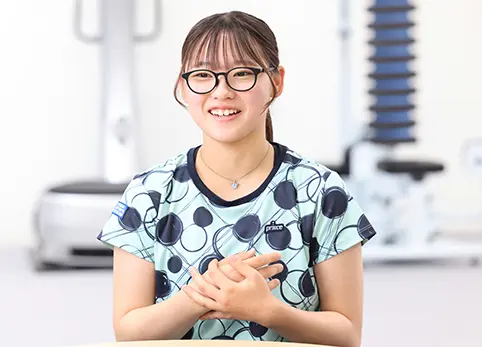
- ITO: Did you ever feel like giving up on wheelchair tennis?
-
Takamuro: [laughing] I tend to be emotionally unstable, so every day it feels like I’m in a slump. I’m always grateful for the support I get from the people around me. They notice when I’m down and help me do better.
But sometimes I think I want to give up playing wheelchair tennis. I’ve felt that off and on especially after I started traveling abroad alone. My English isn’t that great, so I can’t always understand what people are saying. And it’s tough being away from my mom. It’s especially hard visiting countries where they don’t speak English, like Italy. The major tour destinations are in Europe, Asia, and Oceania. Since they don’t speak English in Europe, I use Internet translation services.
-
My doubles partners are from overseas, so we have to communicate by gesture. But if I make a nice shot, they’ll say something encouraging, like Nice! And when people notice I don’t understand the language, they speak slowly. That helps me keep going. Actually, I can’t think of anything else I’d like to do. Right now, for me, there’s just wheelchair tennis. So when I say I want to quit, that might not be what I’m really feeling. [laughing] Even if my mom asks if I want to give up, I keep going.
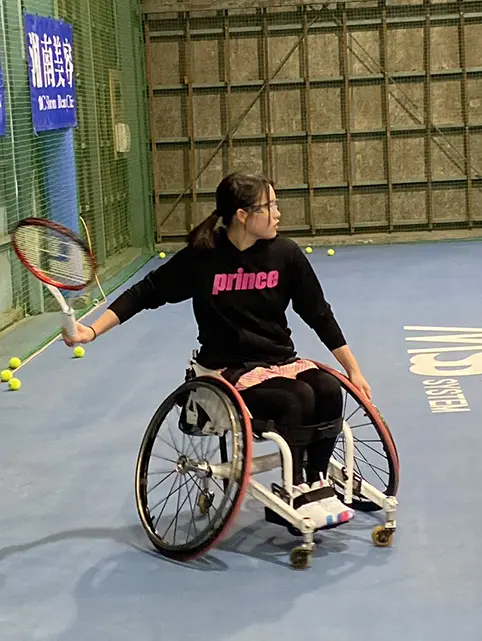
- ITO: With so many international tours, it must be challenging to find time for practice and other activities. How do you schedule your time and daily training?
-
Takamuro: I don’t set a definite annual schedule, but first, I decide how much I want to build on my ranking during the year. Then, I look at the tournament schedule and start planning. I pick my own path by checking how many points I can earn by winning each tournament, then I talk to my coach. I usually play in about 15 tournaments in a year.
I was scratched from certain tournaments this year due to sprains and other reasons, but usually I participate in about 10 international tour visits every year. I spend a little more than a week abroad on each visit. Some athletes travel more frequently and stay longer each time, and some live in Europe for that reason. Living in Europe makes it easier to travel between events because it’s one contiguous continent.
-
If I don’t have a match, I usually practice in the morning, then get therapy or training. I train for about two hours in the gym. I get regular therapy sessions if I feel pain somewhere or have any other conditions. But I’ve been less prone to injury since I started using a treatment device.
A regular routine is key to staying in condition
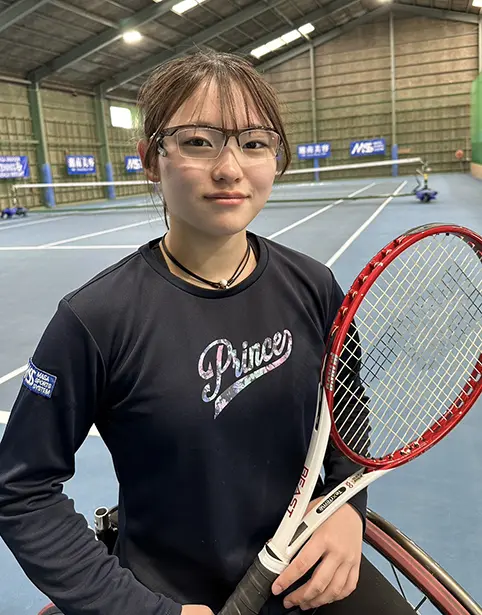
- ITO: It must be very important to maintain high performance in both matches and practice. Do you do anything to manage your condition?
-
Takamuro: [laughing] Although I’ve not been able to pay attention to nutrition or things like that at all, I do get plenty of sleep—maybe too much! I travel a lot by car. We drive from Saitama to Kanagawa for practice. Depending on the traffic, the trip can take up to three hours on some days. I usually sleep while in the car.
My trips abroad involve long flights. I participate in both junior and senior tournaments, so the number of matches per day is high. The average match takes about one hour, and I might play in as many as four matches a day. On a day like that, my body gets really worn out by bedtime, so I try to sleep for at least seven or eight hours. Sometimes I’m awake for only one hour of the day. If I get tired, I’ll go to bed without even taking a bath first. I use a compact low-frequency treatment device before I go to sleep and while I sleep. If I still feel stiff, I’ll stretch before breakfast. I can’t stay in good condition if I depart from this routine even a little.
-
I tell my coach and others if I feel down, and they encourage me during practice. [laughing] My friends encourage me, too. The encouragement makes me feel better and helps stabilize my mood. That’s part of managing my condition, too.
Although I don’t really think about this to help manage my condition that much, I like to read and collect cosmetics, and on my days off, I’ll either go shopping for cosmetics or spend the whole day reading a book. I can get so involved in a book I don’t even notice when my mom says something. I like reading long books and collecting every title in a series. Practice is important, of course, but I think it’s really important to set aside time for other interests, too.
My treatment device is my constant partner.
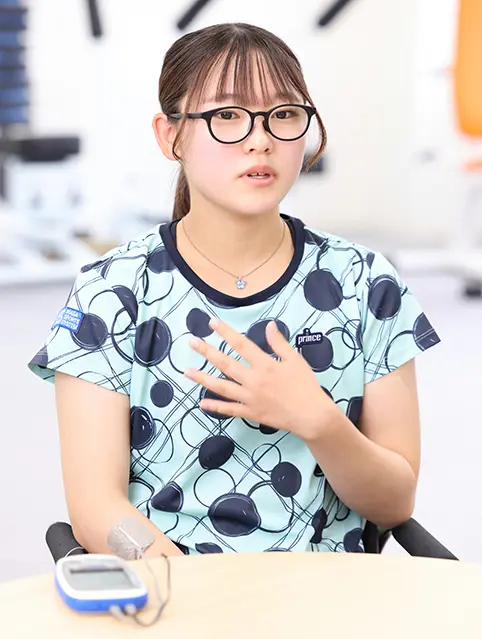
- ITO: When did you start using a treatment device f
-
Takamuro: I borrowed my sister’s treatment device when I injured my wrist and elbow last year. It felt funny to apply electricity to my body for the first time. My body felt so much better afterward. That was the first time I saw the benefits of using a treatment device.
Because of the nature of wheelchair tennis, I often experience pain in my wrists and elbows. To prevent this, I use the treatment device constantly when I’m flying. Sometimes the next passenger will ask: What’s that? I don’t use it right before a match because it alters body sensation in the part, but I do use it while watching other matches after mine.
I basically use low-frequency waves current to ease pain, then use the microcurrent before sleep. I go home to go to bed right after the day’s matches are finished. I use apply the low-frequency waves current in the car on the way back, and then the microcurrent while asleep. I use the treatment device almost every day. It’s become a part of my routine.
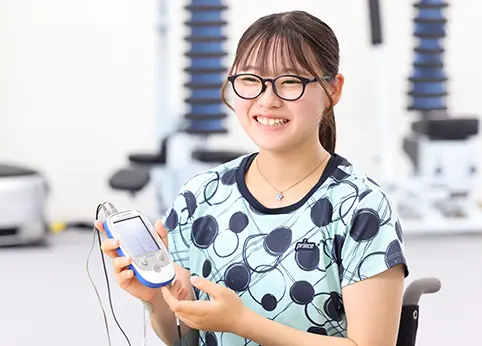
-
I also use a treatment device at the therapy clinic I visit. I go about three times a week for regular care, even if I don’t feel any pain. You become injury-prone if you don’t take proactive care of your body. While I had been undergoing therapy before I started to use the treatment device, it didn’t seem that important to me. But once I started to wear down physically, I saw how important it was.
- ITO: Once you started using the device daily, did you ever feel anxious or worried because you forgot to use it?
-
Takamuro: One time I was so tired after a tournament I just fell asleep without attaching the treatment device. In the next day’s match, my body was really stiff. I felt so tired I didn’t know what to do. I won that match, but it made me realize how important it was to use the treatment device. I did really well in the match on the next day after sleeping with the device attached. The match—which usually takes one hour—took just 30 minutes.
I always keep the treatment device in my bag, because I tend to forget things. [laughing] I’ve even forgotten my passport and my whole bag before!
Winning in global competitions by always aiming higher
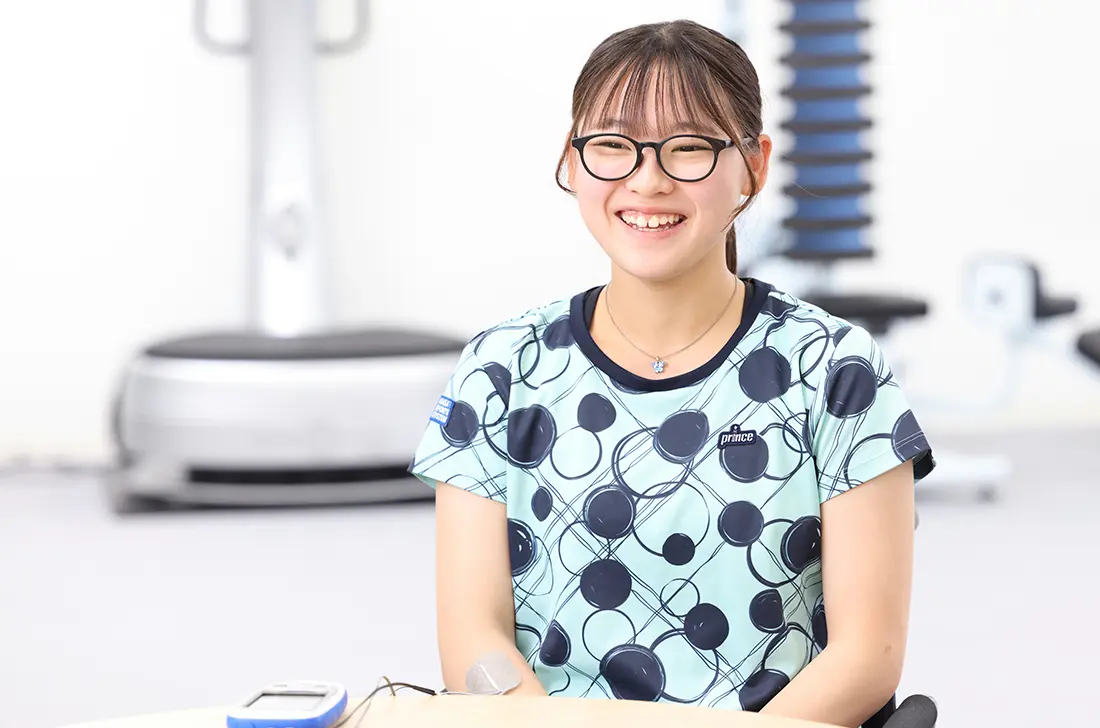
- ITO: Your treatment device is like a partner in your competitive activities. Can you tell us about the tournaments or players you have your eye on right now?
-
Takamuro: Next month I’ll participate in the junior US Open, one of the big four tournaments. Last year, we learned about the junior open just two weeks before the tournament, so there wasn’t much time to prepare. This year, all the competitors are ready and targeting this tournament. So the level of competition will probably be higher than last year. I expect to be better, too. I was runner-up last year. This year my goal is to win the whole thing.
Another goal is to advance to and be placed high in the senior sections of the big four tournaments. A player needs to be ranked within the top 16 to appear in a senior tournament—or the top eight for a junior. Ranking above 20th isn’t easy, but it’s a goal I’ve set for myself.
One player I have my eye on is Yui Kamiji. We were doubles partners in the Kobe tournament this year. I was so nervous I made consecutive errors. She just kept encouraging me, saying things like, It’s all right and Let’s do our best! I think it was thanks to her that we were able to win the tournament. I want to be an athlete who plays while thinking about those around me, just like Kamiji.
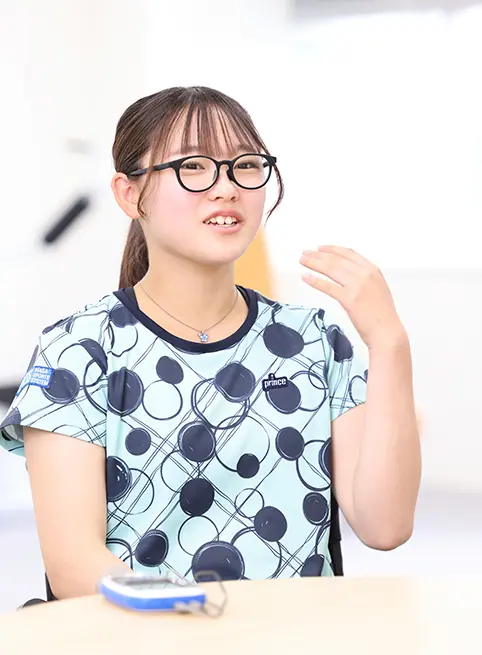
- ITO: Do you see any challenges on the horizon toward your goals? Can you tell us about any specific efforts you’re making now?
-
I don’t have a very muscular build, and my muscular strength is really insufficient. I think I need to train a little more, in particular my abdominal muscles and arms. Right now, beyond regular practice, I’m focusing mainly on training. I also want to improve my stamina a bit more.
Many top-ranking athletes are amputees. They may be missing a leg, but they’re able to walk with a prosthetic leg. So their build isn’t all that different from an athlete with no disability. They tend to have the advantage over athletes with disabilities caused by illness. Differences arise naturally in training, too. Athletes overseas tend to have longer arms and legs than Japanese players, and that’s another source of difference. I need to get stronger to overcome these differences.
-
But I do have my own strengths. As my sense of self-confidence is low, that means I never think I’m a good player, so I never stop practicing. People also compliment me on the speed of my serves, which are faster than those of the current top players. One specific strength is the speed of my forehand. My coach often tells me 30% of my ability is equal to 100% of another player’s. So, my match strategy is to maintain basically a 30-50% level, and then finish up at 100 percent. I plan to achieve my goals by leveraging these strengths and doing what I can to address my weaknesses to the best of my ability.
![Wheelchair tennis player [Yuma Takamuro]](/ito-sports-project/assets/img/interview/008/pct_bio.webp)
Born October 5, 2006 in Tokyo.
Inspired by a chance to experience the game while accompanying her elder sister, wheelchair tennis player Saki Takamuro (a member of the Japan National Team in the Tokyo Paralympics), she began wheelchair tennis in the fourth grade.
After performing well in numerous tournaments beginning in junior high school, she entered high school and went on to become singles champion and doubles runner-up in the Dunlop Kobe Open 2022; singles and doubles runner-up in the Iizuka Open 2022; and doubles champion in the Dunlop Kobe Open 2023.
At the 2022 US Open, she competed in the first junior wheelchair tennis competition to be held as part of a big four tournament, where she was women’s singles runner-up.
